BRAMPTON - Who was Charnjit "Sonny" Bassi planning to shoot and did he have accomplices?
With the fear a contract could have been put out on a witness or lawyer involved in a trial, sources say, Peel police had extensive security at the Davis Courthouse in Brampton on Monday.
And they are not ruling out anything on what the armed Bassi was doing Friday before he was shot and killed by police. Bassi, who was known to police, attempted to breach security and wounded Const. Michael Klarenbeek before being shot.
"Everything is being considered," said an officer. "Everything will be looked at."
Police want to know his movements in the moments before he tried to get into the court with a gun -- and in the previous weeks, too.
They want to know who he spoke with that day and in the weeks before.
They want to know his mood and demeanour. They want to know everything about this gunman and his life.
This is why Peel officers put out a public appeal Monday and released his photograph.
"He was bent on doing something or to get at somebody," said one police source. "No stone will be unturned to try to determine what that was and if there were other people behind it."
This is why police were canvassing Bassi's Brampton neighbourhood, asking the public for help.
But they are also considering this an active investigation -- one that did not die with Bassi.
Several officers said Monday that people might know a small detail or remember a coffee shop meeting that could really help police put this puzzle together.
So far, even though police say they do have an open mind, an investigator explained they do not believe the incident was related to a family court issue or that Bassi was before the courts himself.
As revealed by the Toronto Sun, police suspect Bassi was "targeting someone inside" the courthouse.
Within minutes of the shooting, police were trying to determine the target of this gunman and to find out if he was acting alone or was working with others.
"The reason we cleared the courthouse floor by floor was with the idea in mind that there could be a second person or more," said an officer.
The next thing they did was to try to determine what case could attract such hostility.
Another police source says a scenario being studied is the possibility that Bassi, alone or with others, may have been hired to "neutralize or scare" somebody involved in a case.
Police over the weekend and again Monday were going through security footage at the court to see if he had been there before.
"The goal is to see if there was a dry run or to see if he could be seen with other people," said a detective. "Was there a testing of the security before?"
In my experience with Peel police and their 100% clearance rate on major crime, my advice to those who have been hanging around with Bassi in recent weeks is to contact the force's homicide squad immediately before they contact you.
It's only a matter of time before police connect the dots. As one officer put it, the best thing for someone who knows what this is about is to come and explain it to police before the knock on the door comes.
If you know who "Sonny" Bassi might have been on his way to see in the courthouse Friday, Peel police are anxious to hear from you.
Please share this
Toronto's News, Free Daily News from the Toronto Star, Globe and Mail, Toronto Sun, National Post, CP24, CTV, Global, 640toronto, CFRB, 680 News
Monday, March 31, 2014
Sunday, March 30, 2014
Mystery woman who aided shot cop in courthouse on pot charge
TORONTO -- The fact that a mystery woman — initially thought to be a nurse — dove in to save a wounded police officer’s life Friday was already the stuff of movies.
The plot has thickened.
Not only does it appear that the mystery heroine who helped save Const. Mike Klarenbeek no nurse, she was in Brampton court on pot possession charges.
Of course, no one looked for credentials in the seconds after a gunman seriously wounded the officer. Police shot and killed the gunman in the courthouse on Hurontario St., south of Steeles Ave.
It appears the mystery woman who intervened is Linda Hunt.
“Everything happened so fast and it seemed nobody knew what to do so I did what anybody would do,” Hunt said in an interview.
And nobody was more thankful for her actions than Klarenbeek’s family.
“Mike specifically wanted to thank a nurse, who was at the courthouse that day,” the officer’s wife, Lynn, said in a statement Saturday. “She was the first to tend to him, before the paramedics arrived. He says without her help, it may have had a different outcome.”
Police Sunday night said that Klarenbeek was moved from intensive care and is recovering in hospital. Police would not comment on the identity of the mystery hero.
Hunt, meanwhile, has never been a nurse.
“But I did have St. John’s Ambulance training 28 years ago,” she said Sunday.
It proved useful Friday.
“I have used it a couple of times when I came across car accidents,” she said.
But the resident of Dunchurch, near Parry Sound, who spends the winter in Brampton, had not been in such a situation in years.
Hunt said she suffers from severe knee and back problems and survives on a disability pension. She says she was hurt on the job while working for a company that builds highways and bridges.
“When (the shooting) happened I remembered what they taught me. I knew I could help,” she said.
Hunt, 54, was “sitting in a chair right beside the security station” when the gunman entered. “He came through the staff entrance,” she said.
The next thing she remembers was the sounds of gunshots.
“I think I heard seven shots,” she said from a friend’s house in Minden. “It was scary.”
Hunt would not provide full details of the shooting, explaining she has spoken with the SIU and is scheduled to talk with Peel police detectives on Tuesday.
However, Hunt said she will never forget the officer’s wounds.
Even with her mobility issues, she said, “The adrenaline kicks in and you just do what you have to do.”
She saw Klarenbeek on the floor in obvious distress.
“I saw the blood pumping out of him and I was pretty worried,” she said. “I knew if I didn’t do something immediately, he was going to bleed out.”
Hunt said she was one of the people who dialed 911.
“They can bleed out fast. A lot of people there didn’t know what to do and the police were busy trying to make sure everybody else was safe so I just stuck my hand in around the wounds and kept it there.”
Hunt recalled Klarenbeek was bleeding badly from the abdominal area.
“It is a very dangerous place,” she said. “Basically I applied pressure right to the wound.”
Hunt was accompanied by paralegal Marta McCulligh — wife of lawyer Jack McCulligh — who was there to represent her on a marijuana possession charge.
“She was fearless,” Marta said of Hunt. “She just dove in there without hesitation and really seemed to know what she was doing. I am in awe of her and what she did. She is a hero, no question about it.”
However, said Hunt, it really is not like that. “No way. I am not a hero in any way,” she insisted, adding that police deserve the accolades.
Klarenbeek, she said, is a hero for not letting the gunman get into the courtroom.
“They were all so brave,” she said. “They were so nice to us.”
It was especially appreciated by Hunt, who said she is troubled by her appearance in court on the pot charge.
“I take marijuana to help me with my pain and seizures. I bake it and eat it to help me but I have to deal with it,” she said of her legal problems. “I have not been in trouble before.”
Jack McCulligh called her alleged offence a “minor thing” and said Hunt is a “great person” who did the humane thing.
“Both she and Marta did what they could to help,” said Jack, who was in a courtroom when the shooting happened.
Hunt said, “Marta was also a big part of it” by assisting and keeping the officer comforted.
Same goes for Klarenbeek’s fellow officers, who, she said, were encouraging him.
“I heard them saying hang in there KB. Hang in there KB. I thought it was his nickname,” said Hunt. “I can tell he is well respected. I told them to keep talking to him. It really helped because he was definitely unconscious for a moment there.”
Hunt said she recalled some people heckling her.
“There were some people actually yelling at me for helping a police officer,” she said. “They were telling me to not help him, saying I was despicable.”
She said others were “laughing” while many were “taping it with their cellphones” instead of helping.
“It was awful. I was disgusted with them,” she said.
As for the words from Klarenbeek’s wife, Hunt said she appreciates them.
“It’s very nice,” she said, “but I think I did what anybody who knew first aid would do.”
Though Hunt may have been the saviour who prevented an officer’s funeral, she’s still scheduled to be back in court in April when she hopes there will be less action.
Please share this
The plot has thickened.
Not only does it appear that the mystery heroine who helped save Const. Mike Klarenbeek no nurse, she was in Brampton court on pot possession charges.
Of course, no one looked for credentials in the seconds after a gunman seriously wounded the officer. Police shot and killed the gunman in the courthouse on Hurontario St., south of Steeles Ave.
It appears the mystery woman who intervened is Linda Hunt.
“Everything happened so fast and it seemed nobody knew what to do so I did what anybody would do,” Hunt said in an interview.
And nobody was more thankful for her actions than Klarenbeek’s family.
“Mike specifically wanted to thank a nurse, who was at the courthouse that day,” the officer’s wife, Lynn, said in a statement Saturday. “She was the first to tend to him, before the paramedics arrived. He says without her help, it may have had a different outcome.”
Police Sunday night said that Klarenbeek was moved from intensive care and is recovering in hospital. Police would not comment on the identity of the mystery hero.
Hunt, meanwhile, has never been a nurse.
“But I did have St. John’s Ambulance training 28 years ago,” she said Sunday.
It proved useful Friday.
“I have used it a couple of times when I came across car accidents,” she said.
But the resident of Dunchurch, near Parry Sound, who spends the winter in Brampton, had not been in such a situation in years.
Hunt said she suffers from severe knee and back problems and survives on a disability pension. She says she was hurt on the job while working for a company that builds highways and bridges.
“When (the shooting) happened I remembered what they taught me. I knew I could help,” she said.
Hunt, 54, was “sitting in a chair right beside the security station” when the gunman entered. “He came through the staff entrance,” she said.
The next thing she remembers was the sounds of gunshots.
“I think I heard seven shots,” she said from a friend’s house in Minden. “It was scary.”
Hunt would not provide full details of the shooting, explaining she has spoken with the SIU and is scheduled to talk with Peel police detectives on Tuesday.
However, Hunt said she will never forget the officer’s wounds.
Even with her mobility issues, she said, “The adrenaline kicks in and you just do what you have to do.”
She saw Klarenbeek on the floor in obvious distress.
“I saw the blood pumping out of him and I was pretty worried,” she said. “I knew if I didn’t do something immediately, he was going to bleed out.”
Hunt said she was one of the people who dialed 911.
“They can bleed out fast. A lot of people there didn’t know what to do and the police were busy trying to make sure everybody else was safe so I just stuck my hand in around the wounds and kept it there.”
Hunt recalled Klarenbeek was bleeding badly from the abdominal area.
“It is a very dangerous place,” she said. “Basically I applied pressure right to the wound.”
Hunt was accompanied by paralegal Marta McCulligh — wife of lawyer Jack McCulligh — who was there to represent her on a marijuana possession charge.
“She was fearless,” Marta said of Hunt. “She just dove in there without hesitation and really seemed to know what she was doing. I am in awe of her and what she did. She is a hero, no question about it.”
However, said Hunt, it really is not like that. “No way. I am not a hero in any way,” she insisted, adding that police deserve the accolades.
Klarenbeek, she said, is a hero for not letting the gunman get into the courtroom.
“They were all so brave,” she said. “They were so nice to us.”
It was especially appreciated by Hunt, who said she is troubled by her appearance in court on the pot charge.
“I take marijuana to help me with my pain and seizures. I bake it and eat it to help me but I have to deal with it,” she said of her legal problems. “I have not been in trouble before.”
Jack McCulligh called her alleged offence a “minor thing” and said Hunt is a “great person” who did the humane thing.
“Both she and Marta did what they could to help,” said Jack, who was in a courtroom when the shooting happened.
Hunt said, “Marta was also a big part of it” by assisting and keeping the officer comforted.
Same goes for Klarenbeek’s fellow officers, who, she said, were encouraging him.
“I heard them saying hang in there KB. Hang in there KB. I thought it was his nickname,” said Hunt. “I can tell he is well respected. I told them to keep talking to him. It really helped because he was definitely unconscious for a moment there.”
Hunt said she recalled some people heckling her.
“There were some people actually yelling at me for helping a police officer,” she said. “They were telling me to not help him, saying I was despicable.”
She said others were “laughing” while many were “taping it with their cellphones” instead of helping.
“It was awful. I was disgusted with them,” she said.
As for the words from Klarenbeek’s wife, Hunt said she appreciates them.
“It’s very nice,” she said, “but I think I did what anybody who knew first aid would do.”
Though Hunt may have been the saviour who prevented an officer’s funeral, she’s still scheduled to be back in court in April when she hopes there will be less action.
Please share this
Saturday, March 29, 2014
TTC subway's 60th anniversary
TORONTO - If you are the same age as I am (or perhaps a little younger or maybe even a little older) you’ll probably remember what you were doing exactly 60 years ago Sunday.
Especially if on that day, March 30, 1954, you were anywhere near the intersection of Yonge St., Davisville Ave. and Chaplin Cres.
Here are a few hints: you would have heard the amplified sound of speeches coming from somewhere near the southwest corner of the intersection followed by enthusiastic cheering by crowds of Torontonians who had waited for years for this event to take place.
Then came the blast of an air horn followed immediately by the screech of an old style hockey referee’s whistle. The country’s first subway was officially in business! By the way those speeches you heard were made by Ontario Premier Leslie Frost and Toronto’s flamboyant, in the nicest sense, Mayor Allan Lamport who together started things rolling. With the opening of the Yonge line, something Torontonians had talked about for nearly half a century, our city joined the ranks of half a dozen other North American cities (Boston being the first) that decided in an attempt to alleviate the ever-growing traffic congestion problem they would build expensive, but necessary, underground transportation facilities.
Coincident with the opening of Toronto’s new subway the venerable old Yonge streetcar line (that had started as a horse car route in 1861, the nation’s first) ended.
With the first full week of service under its belt the TTC proudly announced that the 100 bright red English-built all-steel subway cars on hand at the opening (four others test cars made of aluminum and steel were yet to arrive) had a carried a total of 1.8 million passengers on the $50 million (actually $66 million when all the bills were in) along the 7.4-km (4.6-mile) route connecting Union Station at Front and Bay Sts. with Eglinton Ave. And, the official press release went on to state, among the thousands of tokens (at the time a brand new method of fare collection) inserted in the dozens of turnstiles and numerous fare boxes located in the 12 subway stations there wasn’t one “slug.”
Another interesting fact was that while the TTC was still basking in the glow of Canada’s first subway, officials were already discussing what route would be next. Some thought a short $12 million streetcar subway line under Queen St. from McCaul to Sherbourne should be next (never happened) while others were pushing for an $80-million east-west line along Bloor and the Danforth (a dozen years would pass before the first section of that line opened). A third contender was a $20-million subway under either University Ave. (opened 1963) or Spadina Ave. (another no show). Even back then a “downtown relief line” was a not a too far-fetched idea.
What was not disputed however, was the need to continue expanding the city’s subway system.
********
Continuing this week’s TTC theme, as a way of thanking the citizens and business owners affected by the recent lengthy track replacement program along a portion of the Kingston Rd. the Commission is offering FREE rides on its iconic PCC Streamliner streetcar (one of only two remaining from a fleet of 745 such vehicles) from Woodbine Loop (Queen St. E.) to Bingham loop (Victoria Park) from noon until 4 pm. Sunday afternoon.
Please share this
Especially if on that day, March 30, 1954, you were anywhere near the intersection of Yonge St., Davisville Ave. and Chaplin Cres.
Here are a few hints: you would have heard the amplified sound of speeches coming from somewhere near the southwest corner of the intersection followed by enthusiastic cheering by crowds of Torontonians who had waited for years for this event to take place.
Then came the blast of an air horn followed immediately by the screech of an old style hockey referee’s whistle. The country’s first subway was officially in business! By the way those speeches you heard were made by Ontario Premier Leslie Frost and Toronto’s flamboyant, in the nicest sense, Mayor Allan Lamport who together started things rolling. With the opening of the Yonge line, something Torontonians had talked about for nearly half a century, our city joined the ranks of half a dozen other North American cities (Boston being the first) that decided in an attempt to alleviate the ever-growing traffic congestion problem they would build expensive, but necessary, underground transportation facilities.
Coincident with the opening of Toronto’s new subway the venerable old Yonge streetcar line (that had started as a horse car route in 1861, the nation’s first) ended.
With the first full week of service under its belt the TTC proudly announced that the 100 bright red English-built all-steel subway cars on hand at the opening (four others test cars made of aluminum and steel were yet to arrive) had a carried a total of 1.8 million passengers on the $50 million (actually $66 million when all the bills were in) along the 7.4-km (4.6-mile) route connecting Union Station at Front and Bay Sts. with Eglinton Ave. And, the official press release went on to state, among the thousands of tokens (at the time a brand new method of fare collection) inserted in the dozens of turnstiles and numerous fare boxes located in the 12 subway stations there wasn’t one “slug.”
Another interesting fact was that while the TTC was still basking in the glow of Canada’s first subway, officials were already discussing what route would be next. Some thought a short $12 million streetcar subway line under Queen St. from McCaul to Sherbourne should be next (never happened) while others were pushing for an $80-million east-west line along Bloor and the Danforth (a dozen years would pass before the first section of that line opened). A third contender was a $20-million subway under either University Ave. (opened 1963) or Spadina Ave. (another no show). Even back then a “downtown relief line” was a not a too far-fetched idea.
What was not disputed however, was the need to continue expanding the city’s subway system.
********
Continuing this week’s TTC theme, as a way of thanking the citizens and business owners affected by the recent lengthy track replacement program along a portion of the Kingston Rd. the Commission is offering FREE rides on its iconic PCC Streamliner streetcar (one of only two remaining from a fleet of 745 such vehicles) from Woodbine Loop (Queen St. E.) to Bingham loop (Victoria Park) from noon until 4 pm. Sunday afternoon.
Please share this
No shortage of fringe mayoral candidates with a message in Toronto's 2014 election
TORONTO - You don’t have to be a millionaire to run for mayor.
But fringe candidates in every election cling to a nearly impossible dream.
They’re lucky if they get a few hundred to a couple of thousand votes.
The candidate with the fewest votes, of the 40 who were registered in 2010 — Gerald Derome — had 251.
In contrast, Rob Ford received more than 383,501 ballots cast for him. George Smitherman came in second with almost 290,000. Rocco Rossi in fourth got just over 5,000 — and he had withdrawn from the race, although it was too late to remove his name from the ballot.
Every candidate after Rossi scored below 3,500.
This year, 41 have registered to win the big job, according to the city’s election website.
Although the actual fight is currently between five front-runners, if voters really want a fresh face in office, there’s no shortage of them in this race.
There’s Charles Huang, who makes it pretty clear he’s running as a joke.
There’s Morgan Baskin, the 18-year-old high school graduate fed up with the negativity surrounding city politics.
There’s Michael Tasevski, the 23-year-old Ryerson University politics grad who says he can hold his own in a debate with John Tory and Olivia Chow.
There’s pot advocate Matt Mernagh, who wants to address accessibility issues and also wonders whether the daily pain he suffers — and treats with medicinal marijuana — would hinder him on the campaign trail or even in office.
Planks of some of their platforms indicate they have Ford fatigue and also challenge the front-runners to perhaps be more human than politician.
Professor Nelson Wiseman of the University of Toronto says fringe candidates don’t take away from the meatier issues in an election.
“It would be a failure if we went through this whole election and nowhere in the Toronto Sun was it ever noted that there were other people running,” he said.
But he himself doesn’t know any of the fringe candidates because there names won’t matter come election night when the final vote is tallied.
“Unless they’re hallucinating, all of them know they don’t have a chance,” he said.
So why do people run in the face of almost inevitable defeat?
Wiseman said candidates know their reasons best. But to put your name on a ballot for just $200 and “have a million eyeballs exposed to it” could be one.
“So their names might not appear in the paper, but they’re going to be on every single ballot,” he said.
Please share this
But fringe candidates in every election cling to a nearly impossible dream.
They’re lucky if they get a few hundred to a couple of thousand votes.
The candidate with the fewest votes, of the 40 who were registered in 2010 — Gerald Derome — had 251.
In contrast, Rob Ford received more than 383,501 ballots cast for him. George Smitherman came in second with almost 290,000. Rocco Rossi in fourth got just over 5,000 — and he had withdrawn from the race, although it was too late to remove his name from the ballot.
Every candidate after Rossi scored below 3,500.
This year, 41 have registered to win the big job, according to the city’s election website.
Although the actual fight is currently between five front-runners, if voters really want a fresh face in office, there’s no shortage of them in this race.
There’s Charles Huang, who makes it pretty clear he’s running as a joke.
There’s Morgan Baskin, the 18-year-old high school graduate fed up with the negativity surrounding city politics.
There’s Michael Tasevski, the 23-year-old Ryerson University politics grad who says he can hold his own in a debate with John Tory and Olivia Chow.
There’s pot advocate Matt Mernagh, who wants to address accessibility issues and also wonders whether the daily pain he suffers — and treats with medicinal marijuana — would hinder him on the campaign trail or even in office.
Planks of some of their platforms indicate they have Ford fatigue and also challenge the front-runners to perhaps be more human than politician.
Professor Nelson Wiseman of the University of Toronto says fringe candidates don’t take away from the meatier issues in an election.
“It would be a failure if we went through this whole election and nowhere in the Toronto Sun was it ever noted that there were other people running,” he said.
But he himself doesn’t know any of the fringe candidates because there names won’t matter come election night when the final vote is tallied.
“Unless they’re hallucinating, all of them know they don’t have a chance,” he said.
So why do people run in the face of almost inevitable defeat?
Wiseman said candidates know their reasons best. But to put your name on a ballot for just $200 and “have a million eyeballs exposed to it” could be one.
“So their names might not appear in the paper, but they’re going to be on every single ballot,” he said.
Please share this
Friday, March 28, 2014
The Toronto TTC Yonge Subway Line turns 60 years old
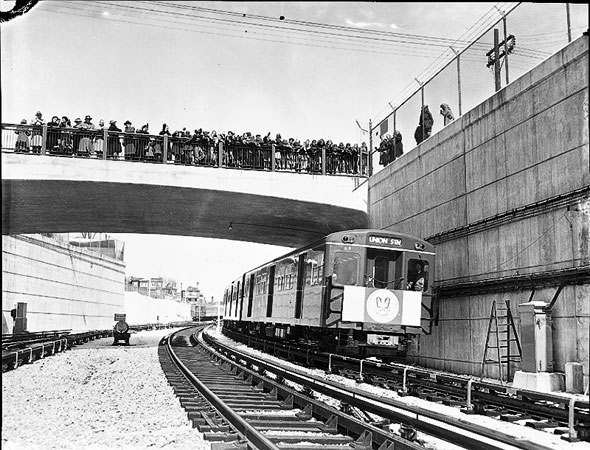
Exactly 60 years ago this Sunday, Toronto mayor Allan Lamport and Ontario premier Leslie Frost gripped a ceremonial lever in front of an eager crowd at Davisville station. When they pushed it forward, a subway signal set up for the gathered photographers changed from red to green. The Yonge line, Canada's first subway, was officially complete.
The TTC's in-house brass band struck up a lively tune as two trains of dignitaries took the inaugural trip north to Eglinton, the end of the line, then rode south to Union. The subway, eight years in the making, opened to the public at exactly 1:30 p.m. Tokens were three for a quarter.
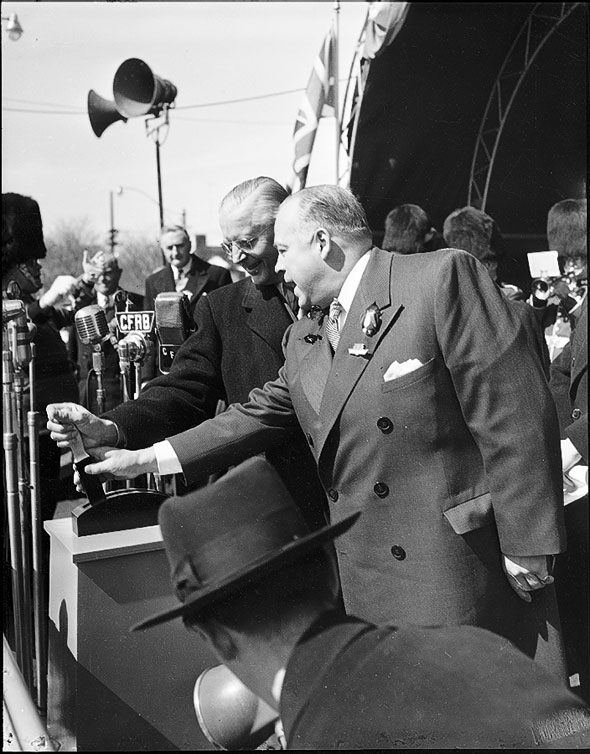 Conceived as one of a pair of subway lines, the other a streetcar tunnel under the downtown portion of Queen Street,
construction on the Yonge subway started in 1949, three years after a
public referendum gave the project the green light (although financial
worries almost killed both projects.)
Conceived as one of a pair of subway lines, the other a streetcar tunnel under the downtown portion of Queen Street,
construction on the Yonge subway started in 1949, three years after a
public referendum gave the project the green light (although financial
worries almost killed both projects.)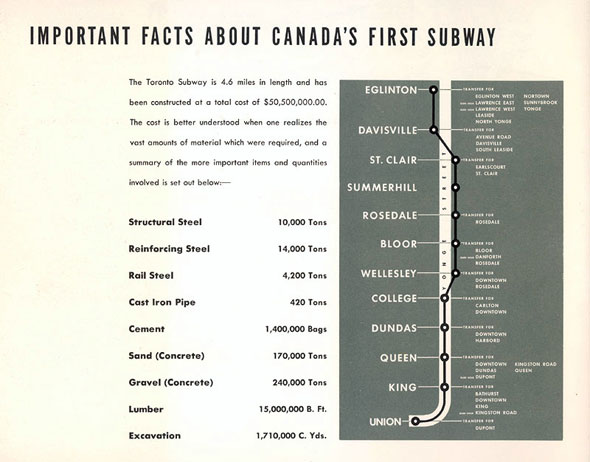
By digging a relatively shallow 7.4 km trench and covering it with heavy wooden planking, the city was able to keep Yonge street and its busy streetcars running while construction continued below. Dynamite blasts, pile drivers, backhoes, and shovels dislodged and removed some 1.3 million cubic metres of soil and rock in a winding strip from Union to Eglinton Avenue.
It took just under 5 years, 24,000 tonnes of steel, and 1.4 million bags of cement to build the physical structure of the line and much more to wire up the signals, install turnstiles, and erect collector booths.
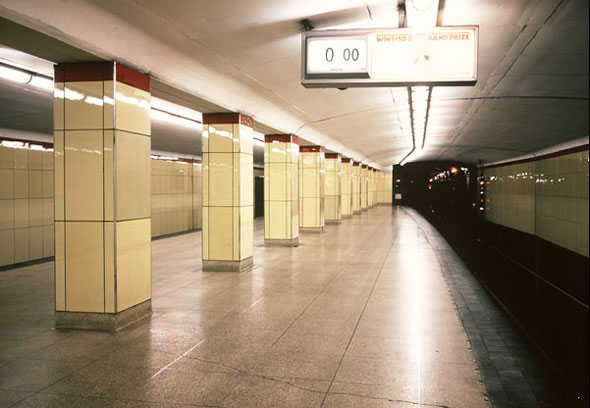
Sadly, black and white pictures of the era rob the Yonge line of its original vibrant aesthetic. The first fleet of 104 "Gloucester" subway trains, built in England at a cost of $7.8 million and shipped to Toronto through the ports of Montreal and Halifax, were painted an startling red. The first map that showed the various surface connections along the line was a bright royal blue and tan.
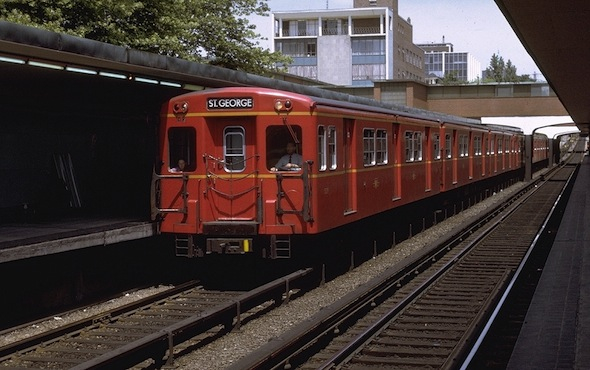
The subway platforms, free from any embellishment due to financial constraints, were decorated using colourful glass tiles that have now mostly been replaced. Each of the 12 stops was finished in one of three colours - Pearl Grey, English Egg Shell (pale green,) or Primrose (soft yellow) - but were gradually transitioned to the current hodgepodge due to the tendency of the tile to shatter like glass. "Pearl Grey" Eglinton is the only station that has kept its Vitrolite wall fixtures.
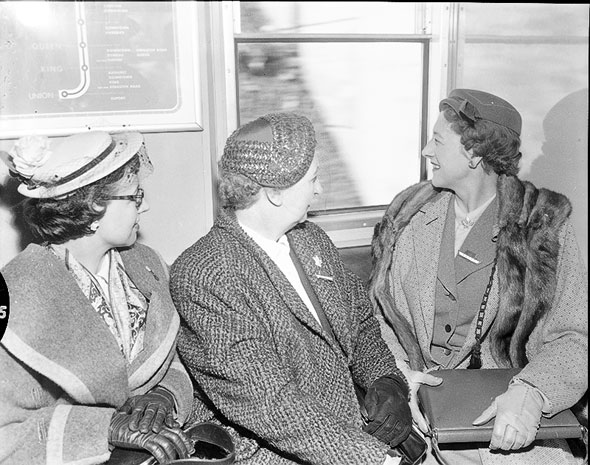
Six decades after that first run, the Yonge line is still the busiest public transit route in the country. Without an outlet valve in the coming decades, it will remain so. In 1954, building the first subway the city so badly needed wasn't without difficulty or money concerns.
As a strangely incredulous CBC television new report from 1954 said: "Toronto got itself a subway - really!"
CBC news report about the opening of the Yonge line
Documentary (with some sound issues) about the construction of the subway
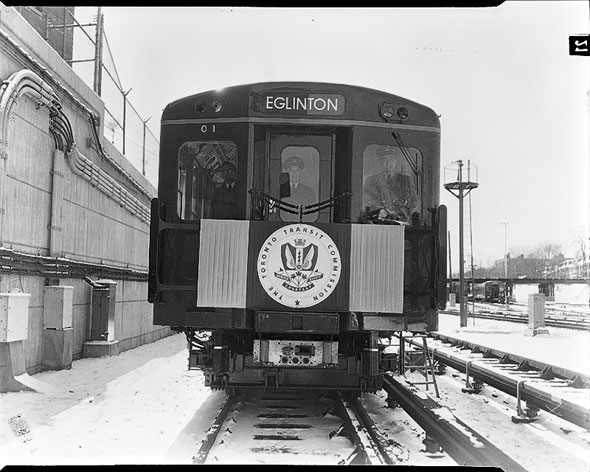
The first train heads north to Eglinton
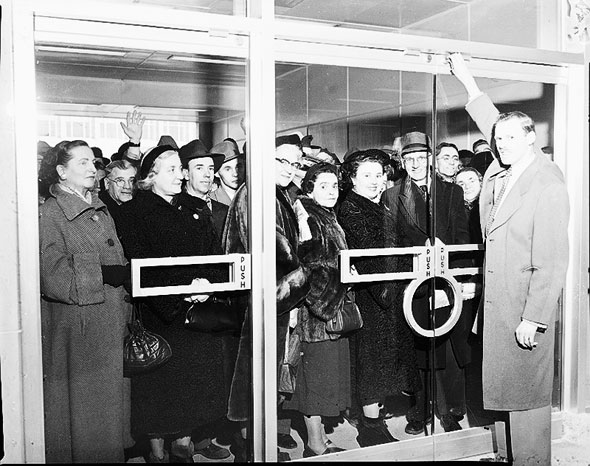
A TTC employee prepares to let the first members of the public onto the subway.
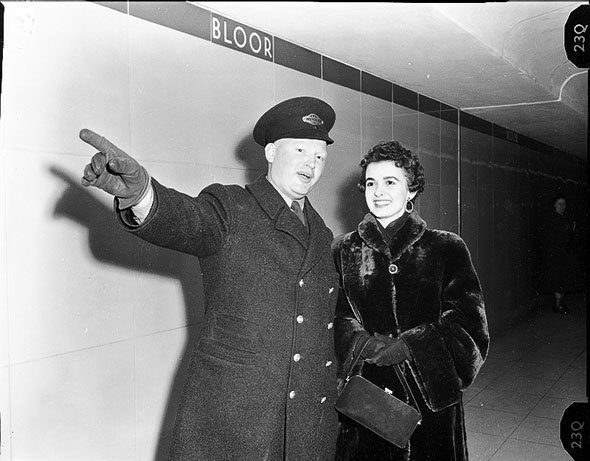
A TTC guide directs a woman at Bloor station.
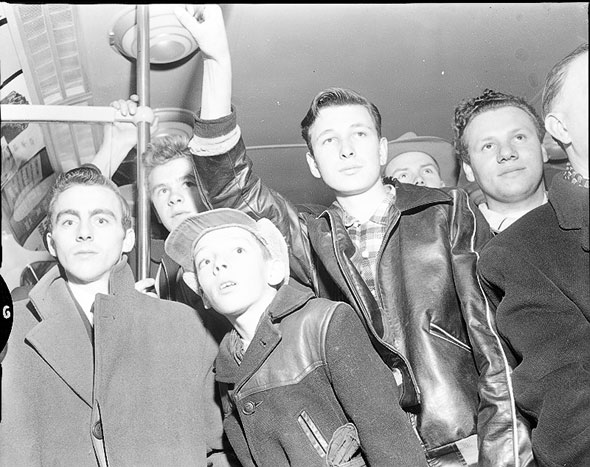
Kids on the first public subway ride.
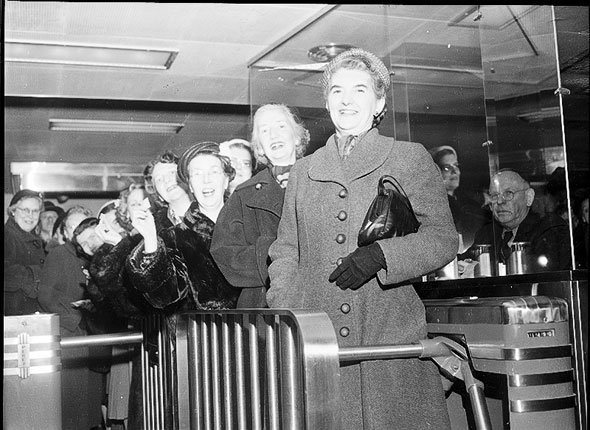
A group of women pay their fares.
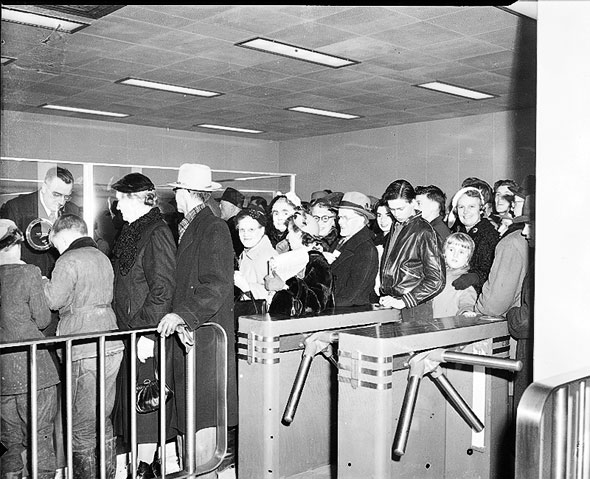
Crowds at the turnstile on opening day.
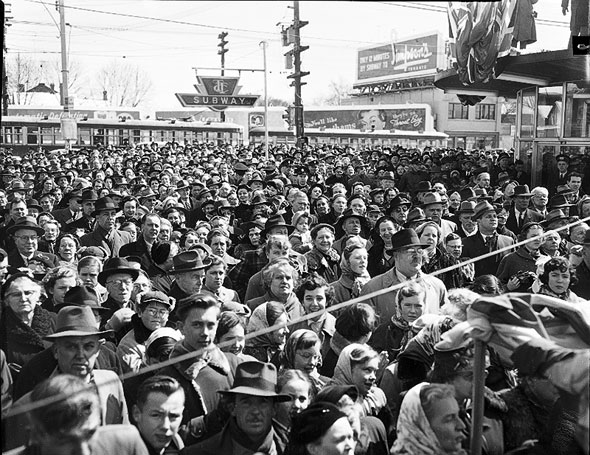 Hundreds gathered outside Davisville station for the opening ceremony.
Hundreds gathered outside Davisville station for the opening ceremony.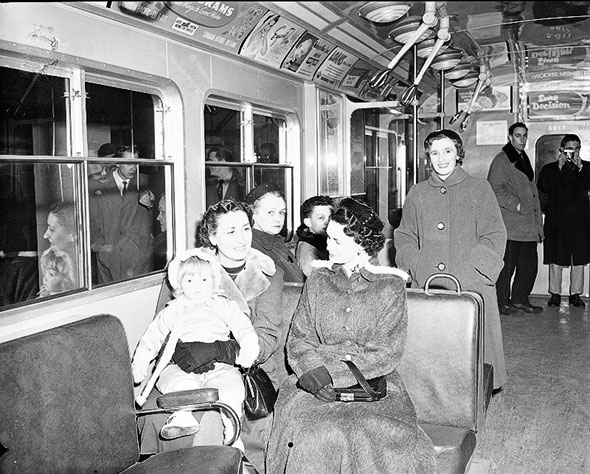 Dignitaries aboard the first train
Dignitaries aboard the first train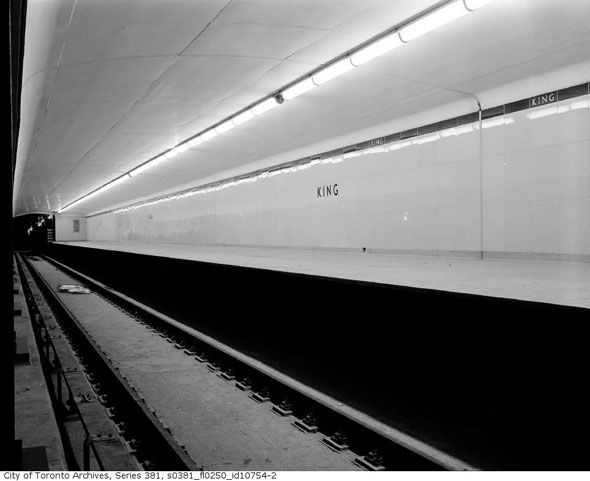
King station shortly before the completion of the subway
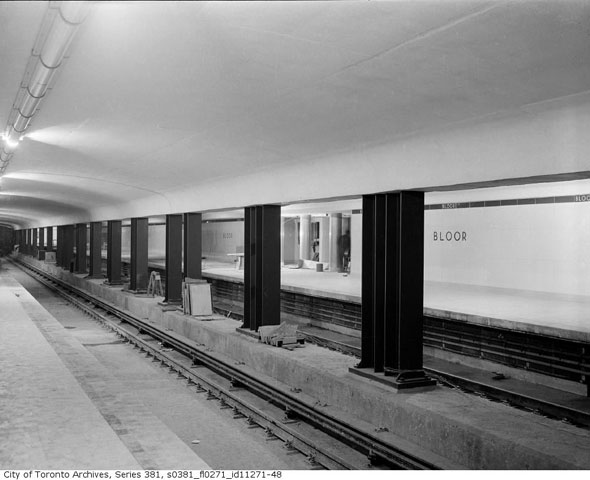
Bloor station before widening and the arrival of the Bloor-Danforth line
Please share this
Thursday, March 27, 2014
Rob Ford claims cops spent $2 million investigating him
TORONTO - Mayor Rob Ford claims Toronto Police have spent almost $2 million investigating him and his crack cocaine scandal is now “water under the bridge.”
Ford made the estimate on the cost of Project Brazen 2 — an investigation launched when news of his crack video first broke — in an interview with Lorne Honickman on AM640 on Thursday as he talked about the previous night’s televised mayoral candidates debate.
“I thought I did very well,” Ford told Honickman when asked about his debate performance.
“Obviously, we go through the film, it is just like a football game — you play a good game but you can always play better.”
Asked if he was surprised none of the other candidates mentioned his crack cocaine use and that it didn’t come up until a reporter asked about it, Ford shrugged.
“They can mention that until the cows come home,” he said. “That’s water under the bridge. People are sick and tired of listening to this over and over and over again.
“What they really want to know is how much did the police spend on investigating this? This must be, they keep going on, going down to San Diego, going here and there, they must be close to $2 million.”
Police have never revealed the cost of the investigation and refused again on Thursday.
“We don’t comment on ongoing criminal investigations,” Toronto Police spokesman Mark Pugash said.
An investigator did travel last month to California — to Cupertino not San Diego — to gain access to Alexander “Sandro” Lisi’s iPhone data. Lisi, Ford’s friend and occasional driver, is charged with extortion in connection with the crack video.
According to an information to obtain a search warrant released by the courts this week, the iPhone contains nine to 10 gigabytes of data and police are looking for evidence of extortion.
“I believe that the data on it will further the investigation and potentially include or exclude other parties as participants or persons of interest in the extortion of (Liban Siyad) for the video featuring (Ford) smoking what appears to be a narcotic,” police state.
On the radio Thursday, the mayor argued he’s focused on the issues and believes people “tune it out” when his crack scandal comes up.
“I’m not perfect, I’ve made mistakes, I’ve owned up to it,” he said.
“Let’s move on … we’re moving on, the past is the past and you’re going to see in the next six months my performance.”
Please share this
Ford made the estimate on the cost of Project Brazen 2 — an investigation launched when news of his crack video first broke — in an interview with Lorne Honickman on AM640 on Thursday as he talked about the previous night’s televised mayoral candidates debate.
“I thought I did very well,” Ford told Honickman when asked about his debate performance.
“Obviously, we go through the film, it is just like a football game — you play a good game but you can always play better.”
Asked if he was surprised none of the other candidates mentioned his crack cocaine use and that it didn’t come up until a reporter asked about it, Ford shrugged.
“They can mention that until the cows come home,” he said. “That’s water under the bridge. People are sick and tired of listening to this over and over and over again.
“What they really want to know is how much did the police spend on investigating this? This must be, they keep going on, going down to San Diego, going here and there, they must be close to $2 million.”
Police have never revealed the cost of the investigation and refused again on Thursday.
“We don’t comment on ongoing criminal investigations,” Toronto Police spokesman Mark Pugash said.
An investigator did travel last month to California — to Cupertino not San Diego — to gain access to Alexander “Sandro” Lisi’s iPhone data. Lisi, Ford’s friend and occasional driver, is charged with extortion in connection with the crack video.
According to an information to obtain a search warrant released by the courts this week, the iPhone contains nine to 10 gigabytes of data and police are looking for evidence of extortion.
“I believe that the data on it will further the investigation and potentially include or exclude other parties as participants or persons of interest in the extortion of (Liban Siyad) for the video featuring (Ford) smoking what appears to be a narcotic,” police state.
On the radio Thursday, the mayor argued he’s focused on the issues and believes people “tune it out” when his crack scandal comes up.
“I’m not perfect, I’ve made mistakes, I’ve owned up to it,” he said.
“Let’s move on … we’re moving on, the past is the past and you’re going to see in the next six months my performance.”
Please share this
Tuesday, March 25, 2014
What Kingston Road used to look like in Toronto
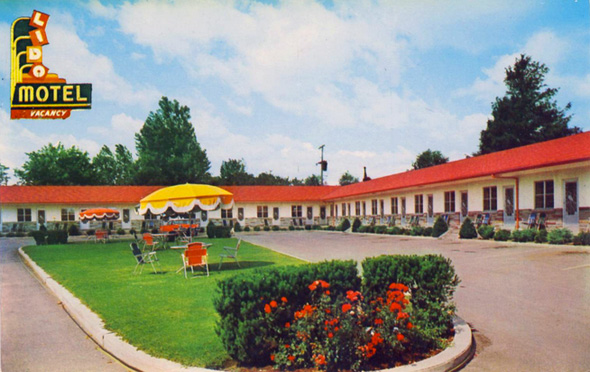 Kingston
Road doesn't pose much of a challenge from an etymology standpoint.
Once the easterly route from Toronto to Kingston, the road dates back to
the outset of the 19th century when Asa Danforth was tasked with
building a route linking Toronto with the Trent River. While Danforth's road
made it all the way east, it never really took and fell into disrepair
soon after completion. 15 years later, Kingston Road was built following
mostly the same path. During the almost two centuries that have
followed, Kingston Road made up a huge chunk of Highway 2, a route that
still cuts across Southern Ontario even though it was removed from the
official highway system in 1998.
Kingston
Road doesn't pose much of a challenge from an etymology standpoint.
Once the easterly route from Toronto to Kingston, the road dates back to
the outset of the 19th century when Asa Danforth was tasked with
building a route linking Toronto with the Trent River. While Danforth's road
made it all the way east, it never really took and fell into disrepair
soon after completion. 15 years later, Kingston Road was built following
mostly the same path. During the almost two centuries that have
followed, Kingston Road made up a huge chunk of Highway 2, a route that
still cuts across Southern Ontario even though it was removed from the
official highway system in 1998.Once served by a radial railway, Kingston Road has always been an important street in Toronto. Businesses capitalized on the travellers making their way to and from eastern destinations, which afforded the Toronto portion of the street a rather vibrant retail scene earlier than other places to the east of downtown. It was also, rather naturally given its function, a place where some of Toronto's earliest tourist cabins were located.
The Kingston Road motel strip still clings to life today, but back in the 1950s it was positively booming. Prior to the 401, Highway 2 was a major east/west route through the province, and tourists were attracted to the cheap accommodation and proximity to the Scarborough Bluffs. These weren't rundown, shitty places. Take a look at the Roycroft Motel in the 1950s below. Now something of a concrete bunker, it's parking lot pool seems wonderfully optimistic and leisurely.
The whole strip of motels was, in fact, brimming with activity until the traffic dried up in the 1960s, thus mirroring the situation in the US with the rise of the Interstate. One suspects that the remaining motels will be gone in the next decade or so, depending on the level of condo pressure. The purge has already happened on Lake Shore, so that's not a particularly brave prediction to make.
Here's a look at Kingston Road when it was on the upswing.
PHOTOS
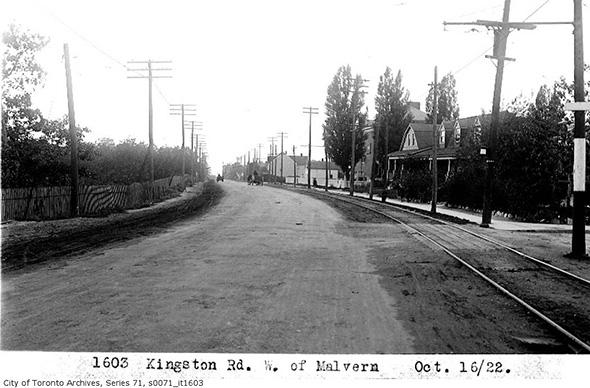 Kingston Road looking west from Malvern, 1922
Kingston Road looking west from Malvern, 1922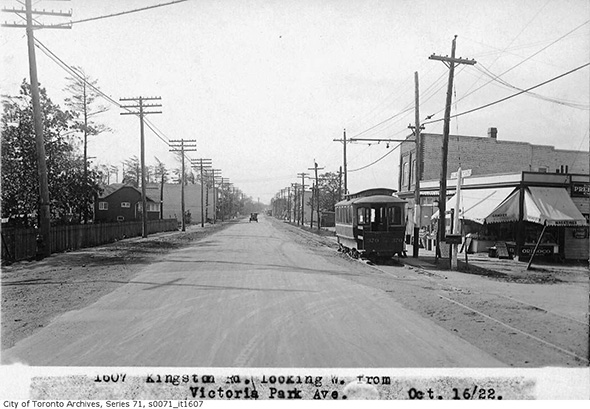 Kingston Road looking west from Victoria Park, 1922
Kingston Road looking west from Victoria Park, 1922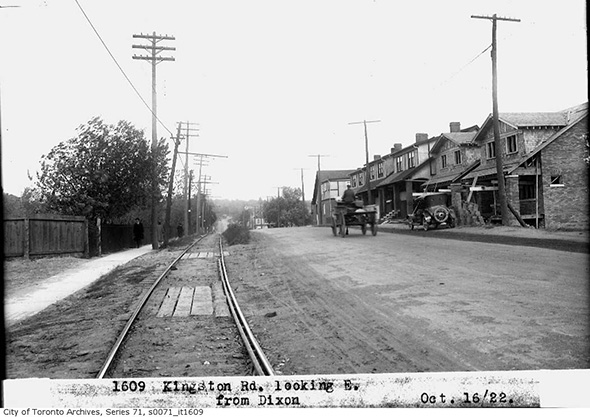 Kingston Road looking east from Dixon, 1922
Kingston Road looking east from Dixon, 1922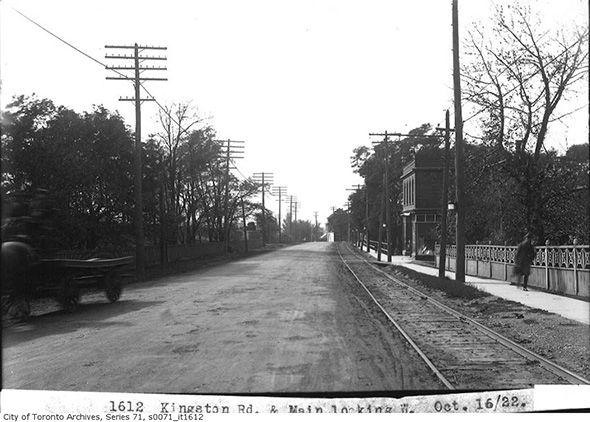 Kingston Road looking west from Main St., 1922
Kingston Road looking west from Main St., 1922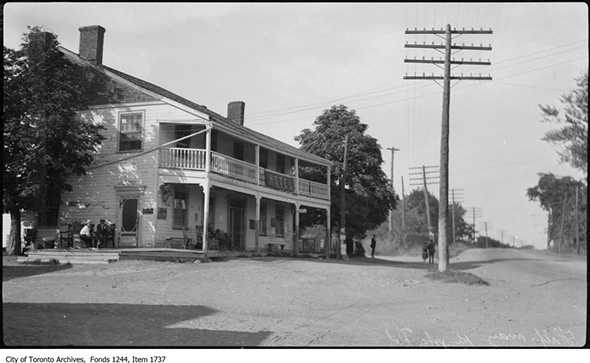 Hotel / Halfway House at Kingston Road and Midland, 1922
Hotel / Halfway House at Kingston Road and Midland, 1922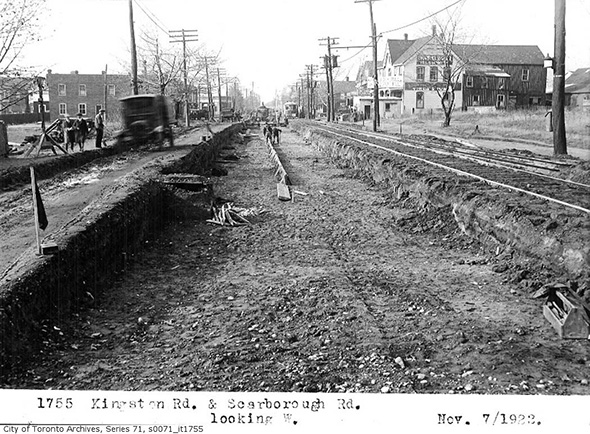 Kingston Road looking west from Scarborough Road, 1922
Kingston Road looking west from Scarborough Road, 1922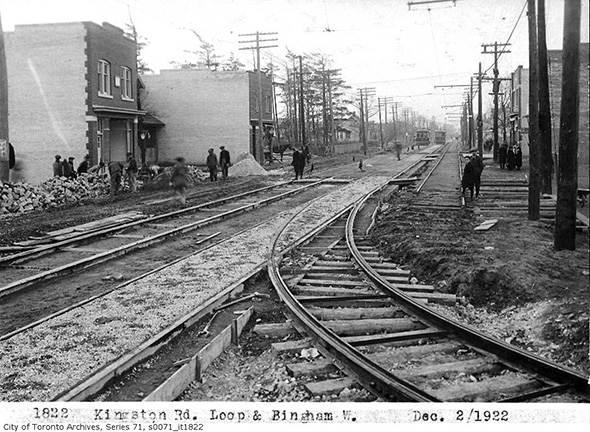 Kingston Road and Bingham, 1922
Kingston Road and Bingham, 1922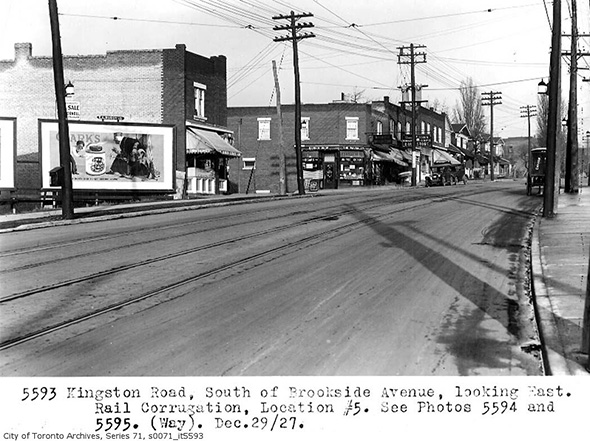 Kingston Road looking east from Brookside, 1927
Kingston Road looking east from Brookside, 1927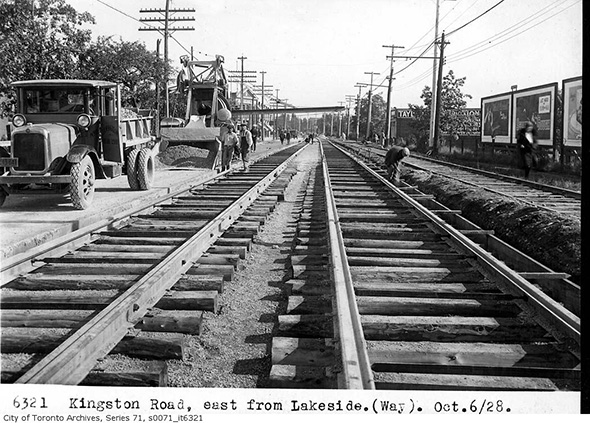 Kingston Road east from Lakeside, 1928
Kingston Road east from Lakeside, 1928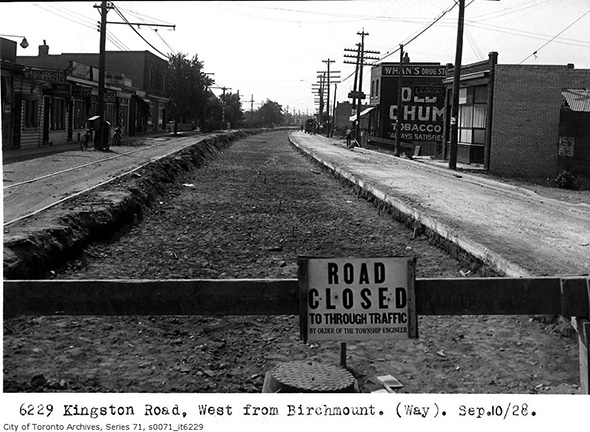 Kingston Road west from Birchmount, 1928
Kingston Road west from Birchmount, 1928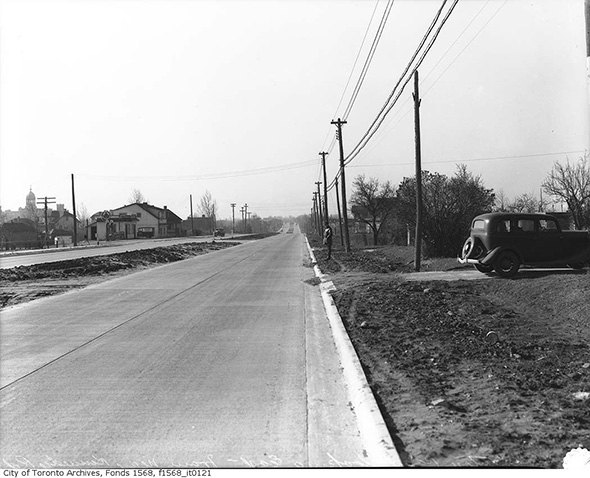 Kingston Road looking west toward Brimley, 1930s
Kingston Road looking west toward Brimley, 1930s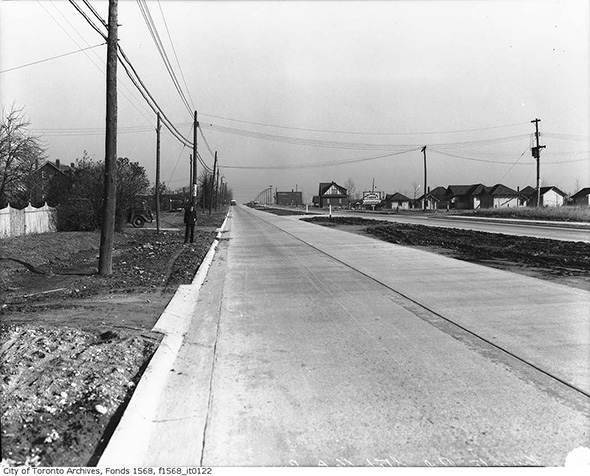 Early tourist cabins near Brimley, 1930s
Early tourist cabins near Brimley, 1930s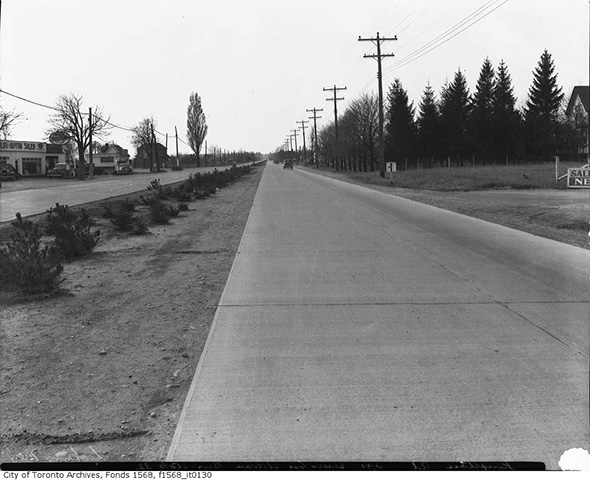 Kingston Road looking west from near Lawrence, 1930s
Kingston Road looking west from near Lawrence, 1930s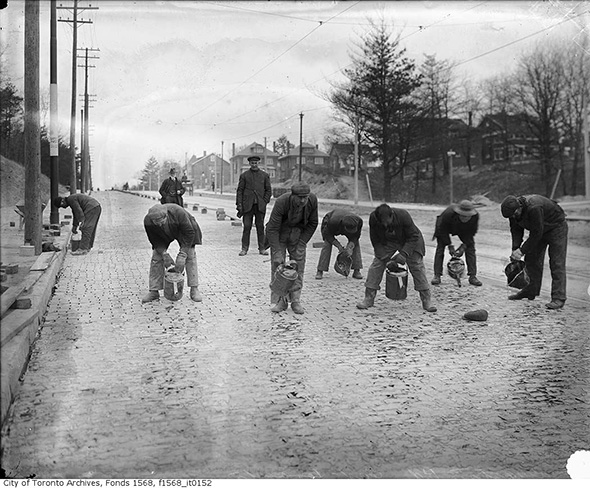
Looking east toward Cliffside, 1930s
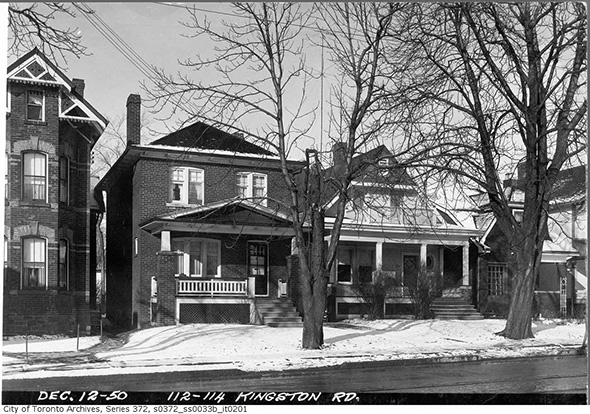
114 Kingston Road, 1950
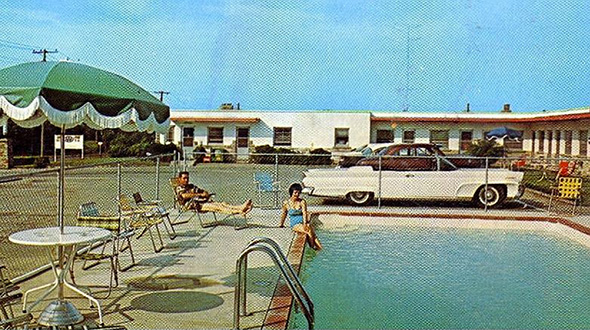 Roycroft Motel, 1950s
Roycroft Motel, 1950s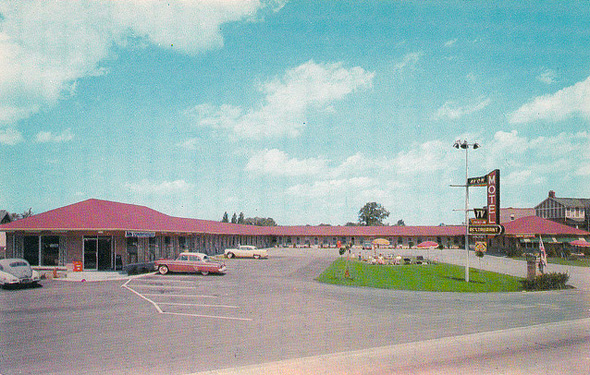
Avon Motel, 1950s
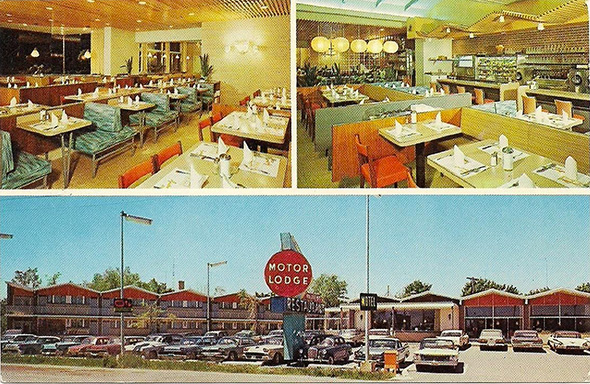 Andrews Motor Lodge, 1960s
Andrews Motor Lodge, 1960s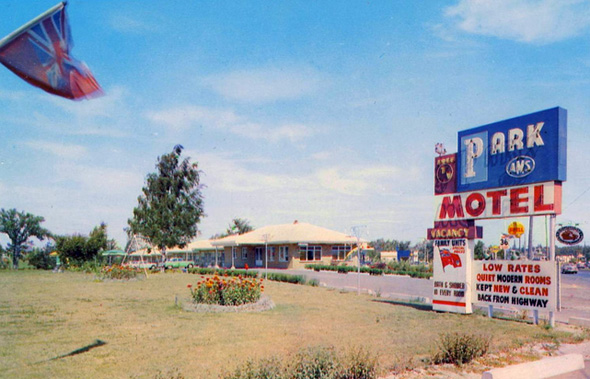
Park Motel, 1960s
Olivia Chow campaign raises $378Gs in two weeks
TORONTO - Olivia Chow has raised almost $400,000 in the first two weeks of her mayoral run.
The Chow campaign announced Tuesday that it has already raised $378,785 from 1,914 donors.
Chow entered the race March 12 — the same day she resigned as the NDP MP for the downtown riding of Trinity-Spadina.
Organizers said the campaign aimed to raise $250,000 during Chow’s first week as a candidate but had surpassed the $378,000 mark by Monday night.
“It’s a strong start that underlines our city’s desire for a new mayor after four years of disappointing leadership,” Chow’s campaign stated in a press release.
Chow’s fundraising total so far amounts to 29% of the maximum any mayoral candidate can spend to seek the top municipal job. Voters go to the polls Oct. 27.
The preliminary spending limit for the mayoral race is $1,305,066, according to the city.
Individuals can donate a maximum of $2,500 to anyone trying to become mayor.
Mayor Rob Ford shrugged off Chow’s announcement.
“All the power to her,” Ford said at City Hall Tuesday. “I wish her the best of luck.”
A spokesman for the John Tory campaign refused to reveal how much money has been raised for the former Ontario PC leader’s mayoral bid.
“We’ll come out with our individual donations at a future time during the campaign,” said Tory spokesman Erika Mozes. “I’m not going to release them just because another campaign has.”
Please share this
The Chow campaign announced Tuesday that it has already raised $378,785 from 1,914 donors.
Chow entered the race March 12 — the same day she resigned as the NDP MP for the downtown riding of Trinity-Spadina.
Organizers said the campaign aimed to raise $250,000 during Chow’s first week as a candidate but had surpassed the $378,000 mark by Monday night.
“It’s a strong start that underlines our city’s desire for a new mayor after four years of disappointing leadership,” Chow’s campaign stated in a press release.
Chow’s fundraising total so far amounts to 29% of the maximum any mayoral candidate can spend to seek the top municipal job. Voters go to the polls Oct. 27.
The preliminary spending limit for the mayoral race is $1,305,066, according to the city.
Individuals can donate a maximum of $2,500 to anyone trying to become mayor.
Mayor Rob Ford shrugged off Chow’s announcement.
“All the power to her,” Ford said at City Hall Tuesday. “I wish her the best of luck.”
A spokesman for the John Tory campaign refused to reveal how much money has been raised for the former Ontario PC leader’s mayoral bid.
“We’ll come out with our individual donations at a future time during the campaign,” said Tory spokesman Erika Mozes. “I’m not going to release them just because another campaign has.”
Please share this
Monday, March 24, 2014
Ephraim’s Place takes shape: Downsview
Ephraim Brown was attending his cousin’s birthday party in July, 2007, when he was hit by a stray bullet during a gang shootout. He died on the sidewalk near his home on Sheppard Ave. He was 11 years old.
Ephraim lived in a community housing complex; after his death, his family moved away, and the house stood empty.
There was a brief period when it was used for a homework club for neighbourhood kids, and there were plans for other programming; this happened when a delegation of Ephraim’s friends and playmates went downtown and appealed in person to Gene Jones at TCHC headquarters.
Alas, the funding for the homework club ran out recently, and the house is empty again, and here I remind you that there is still a very long waiting list of people who have no place to live.
Now the good news.
Across the street from the house where Ephraim lived is the Emmanuel Church of the Nazarene. The church has a big, high-ceilinged, multi-purpose gym with a kitchen. After the boy’s death, it was christened Ephraim’s Place.
It, too, was a resource for neighbourhood kids but it was falling apart, and the church is not wealthy, and while it may not be quite as simple as a couple of phone calls, here’s what happened:
Councillor Maria Augimeri called former councillor Joe Pantalone, who does some work on behalf of the Labourers’ International Union of North America, and Joe called the union, and the next thing you know there are organizers and office staff all over the gym, sanding the floor, slapping paint on the walls, and getting ready to put in a new stove.
On their own time.
With donated material.
I dropped by the other day: the sound of power tools, the smell of paint, the good-natured laughter of good people doing good work.
Roly Bernardini is the president of Local 506. He said, “We wanted to get involved in something. Joe Pantalone brought us here.”
At first, the union was just going to do the floor. Roly said, “We looked around. We said, ‘Let’s do it all.’”
And so they rounded up paint and tiles and plaster, and a new stove and range hood, and the provincial council of the union donated money for cabinets. Roly said, “We’re coming in after work, and on days off. There are 25 or 30 volunteers.”
Pastor Bill Sunberg said that the floor, all by itself, would have cost $5,000 to replace. Roly said, “At the end of the day, this is a $60,000 job.” He also said, “The key was the story of Ephraim.”
The gym is a textbook example of a good workplace: all tools in their place, drops cloths neatly spread, materials properly organized. One guy was running a sander. Him, I had to remind about earplugs.
It’s a thing of mine.
There were a couple of women in the kitchen with paint rollers and brushes. When I paint, I also decorate myself. They were spotless.
I asked Merissa Preston what she does by day. She said, “I connect apprentices to contractors.” How does she like using a roller? She laughed and said, “I’ve never done physical labour.”
And Isabella Costanzo said, “I’m the office manager for Local 506. This is the first time I’ve ever picked up a paintbrush. I love it. I appreciate more what our members do. It’s tiring. I’m happy. It’s rewarding.”
It gets better.
Roly said, “We’re thinking of getting people from the neighbourhood to do apprenticeships and training.” It occurs to me that Ephraim, were he still alive, would be very nearly old enough now for one of those apprenticeships.
Please share this
Ephraim lived in a community housing complex; after his death, his family moved away, and the house stood empty.
There was a brief period when it was used for a homework club for neighbourhood kids, and there were plans for other programming; this happened when a delegation of Ephraim’s friends and playmates went downtown and appealed in person to Gene Jones at TCHC headquarters.
Alas, the funding for the homework club ran out recently, and the house is empty again, and here I remind you that there is still a very long waiting list of people who have no place to live.
Now the good news.
Across the street from the house where Ephraim lived is the Emmanuel Church of the Nazarene. The church has a big, high-ceilinged, multi-purpose gym with a kitchen. After the boy’s death, it was christened Ephraim’s Place.
It, too, was a resource for neighbourhood kids but it was falling apart, and the church is not wealthy, and while it may not be quite as simple as a couple of phone calls, here’s what happened:
Councillor Maria Augimeri called former councillor Joe Pantalone, who does some work on behalf of the Labourers’ International Union of North America, and Joe called the union, and the next thing you know there are organizers and office staff all over the gym, sanding the floor, slapping paint on the walls, and getting ready to put in a new stove.
On their own time.
With donated material.
I dropped by the other day: the sound of power tools, the smell of paint, the good-natured laughter of good people doing good work.
Roly Bernardini is the president of Local 506. He said, “We wanted to get involved in something. Joe Pantalone brought us here.”
At first, the union was just going to do the floor. Roly said, “We looked around. We said, ‘Let’s do it all.’”
And so they rounded up paint and tiles and plaster, and a new stove and range hood, and the provincial council of the union donated money for cabinets. Roly said, “We’re coming in after work, and on days off. There are 25 or 30 volunteers.”
Pastor Bill Sunberg said that the floor, all by itself, would have cost $5,000 to replace. Roly said, “At the end of the day, this is a $60,000 job.” He also said, “The key was the story of Ephraim.”
The gym is a textbook example of a good workplace: all tools in their place, drops cloths neatly spread, materials properly organized. One guy was running a sander. Him, I had to remind about earplugs.
It’s a thing of mine.
There were a couple of women in the kitchen with paint rollers and brushes. When I paint, I also decorate myself. They were spotless.
I asked Merissa Preston what she does by day. She said, “I connect apprentices to contractors.” How does she like using a roller? She laughed and said, “I’ve never done physical labour.”
And Isabella Costanzo said, “I’m the office manager for Local 506. This is the first time I’ve ever picked up a paintbrush. I love it. I appreciate more what our members do. It’s tiring. I’m happy. It’s rewarding.”
It gets better.
Roly said, “We’re thinking of getting people from the neighbourhood to do apprenticeships and training.” It occurs to me that Ephraim, were he still alive, would be very nearly old enough now for one of those apprenticeships.
Please share this
Rob Ford: Funding BMO Field 'corporate welfare'
TORONTO - Mayor Rob Ford calls the deal to use $30 million of public money to renovate BMO Field “crazy.”
Maple Leaf Sports and Entertainment president Tim Leiweke says it’s actually a “good investment” that will in the long run save the city millions and even make them some money.
The battle lines are clearly drawn between two flamboyant leaders who are passionate about their positions.
To allow for the Toronto Argonauts to eventually play in an upgraded stadium, and to improve the experience on and off the pitch for Major League Soccer, MLSE has put forward a plan to invest $90 million into the team to go with $10 million from each of the province, the federal government and the city — with the city’s end being repaid with interest over a 20-year period.
Ford was the only member of city council’s executive committee to vote against the deal.
“It all comes from the same purse,” Ford said in an interview Monday. “It’s corporate welfare.”
The mayor said he wonders why MLSE doesn’t borrow the money from a traditional bank like BMO, whose name is on the stadium. Or use some of the estimated extra $17 million made from selling the naming rights to pay.
“We are not a bank,” said the mayor.
In fact, he said, for the city to partake in this “we have to borrow that money to lend it to them” and “that is not what government is supposed to do. To borrow money from the city like that is unheard of.”
Ford said he “can’t understand why the federal and provincial governments haven’t said something about it as well.”
His position is the taxpayers already paid $55 million to build the stadium.
But in an interview, Leiweke said he does not see it as a loan but more of an investment that will in the end save the city money.
The city-owned-stadium is subject to the winter and tough elements and will be in need of repair before long.
Instead of having to pay that, said Leiweke, MLSE is covering most of the expense and taking most of the risk by putting in a new roof to keep fans out of the rain and to protect the seats and structure.
“He must think we just fell off the turnip truck,” said Councillor Doug Ford, who teased he calls Leiweke “Mr. Hollywood.”
But to his credit Leiweke, who called out the mayor in a season ticket holders meeting by saying he was glad he was not on side, said he wanted to “settle down” the tiff and make it clear “I have nothing against the mayor” and “won’t be getting involved” in the mayoral election campaign or “supporting” any candidate.
He said he “gets” where the mayor is coming from and hopes he can better explain MLSE’s position.
“It’s not corporate welfare,” Leiweke insists. “For the community” it’s “a good, fair deal.”
Ford said he still has great respect for MLSE but just feels they have the money to pay for this renovation themselves.
Please share this
Maple Leaf Sports and Entertainment president Tim Leiweke says it’s actually a “good investment” that will in the long run save the city millions and even make them some money.
The battle lines are clearly drawn between two flamboyant leaders who are passionate about their positions.
To allow for the Toronto Argonauts to eventually play in an upgraded stadium, and to improve the experience on and off the pitch for Major League Soccer, MLSE has put forward a plan to invest $90 million into the team to go with $10 million from each of the province, the federal government and the city — with the city’s end being repaid with interest over a 20-year period.
Ford was the only member of city council’s executive committee to vote against the deal.
“It all comes from the same purse,” Ford said in an interview Monday. “It’s corporate welfare.”
The mayor said he wonders why MLSE doesn’t borrow the money from a traditional bank like BMO, whose name is on the stadium. Or use some of the estimated extra $17 million made from selling the naming rights to pay.
“We are not a bank,” said the mayor.
In fact, he said, for the city to partake in this “we have to borrow that money to lend it to them” and “that is not what government is supposed to do. To borrow money from the city like that is unheard of.”
Ford said he “can’t understand why the federal and provincial governments haven’t said something about it as well.”
His position is the taxpayers already paid $55 million to build the stadium.
But in an interview, Leiweke said he does not see it as a loan but more of an investment that will in the end save the city money.
The city-owned-stadium is subject to the winter and tough elements and will be in need of repair before long.
Instead of having to pay that, said Leiweke, MLSE is covering most of the expense and taking most of the risk by putting in a new roof to keep fans out of the rain and to protect the seats and structure.
“He must think we just fell off the turnip truck,” said Councillor Doug Ford, who teased he calls Leiweke “Mr. Hollywood.”
But to his credit Leiweke, who called out the mayor in a season ticket holders meeting by saying he was glad he was not on side, said he wanted to “settle down” the tiff and make it clear “I have nothing against the mayor” and “won’t be getting involved” in the mayoral election campaign or “supporting” any candidate.
He said he “gets” where the mayor is coming from and hopes he can better explain MLSE’s position.
“It’s not corporate welfare,” Leiweke insists. “For the community” it’s “a good, fair deal.”
Ford said he still has great respect for MLSE but just feels they have the money to pay for this renovation themselves.
Please share this
Sunday, March 23, 2014
A brief history of the Horseshoe Tavern in Toronto
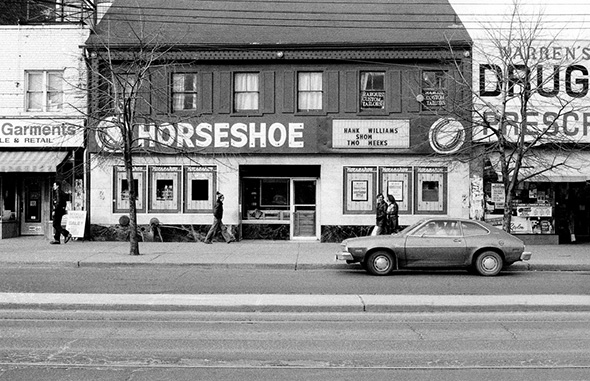
There is no live music club in Toronto with more history attached to it than the Horseshoe Tavern. Beyond just longevity, the Queen West institution has played a central role in each generation of Toronto's music scene since the '50s, and continues to thrive. Even more impressive is that it's managed to maintain its unique country-bar-in-the-city identity, adjusting only slightly with each passing of the torch.
The building at 370 Queen West was originally built in 1861, and was initially a blacksmith shop (which is perhaps the source of its later name). It went through several other incarnations for many decades, including a shoe shop and a fancy goods store. It wasn't until 1947 that a change in Ontario's liquor laws inspired Jack Starr to convert it into a tavern, which opened December 9 of that year.
In the beginning, the focus was more on beer and food, but in the mid-50s Starr gutted the kitchen, built a stage and began booking country and rockabilly acts. Even as the rock'n'roll revolution swept the rest of the world, Starr continued to keep the focus on country acts by hiring Dick Nolan and his Blue Valley Boys as the house band, and by bringing in big name touring acts.
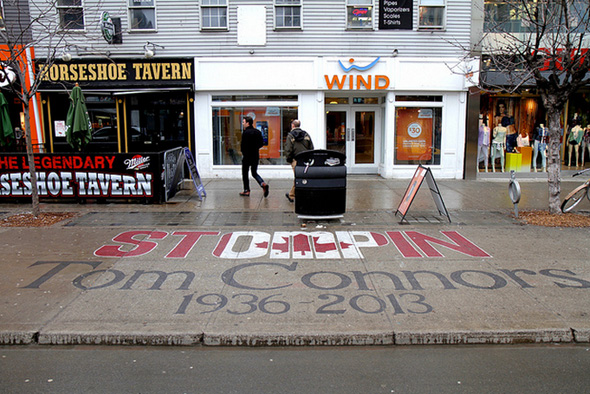
This first golden era of the 'Shoe was a great success, and attracted twang royalty like Willie Nelson, Conway Twitty, Waylon Jennings, the Carter Family, Loretta Lynn, Kitty Wells and many more. It was also where a young Stompin' Tom Connors started building a name for himself. Connors played extended residencies at the Horseshoe, at one point hitting the stage for 25 nights in a row, and eventually recorded a live album as well as two concert films at the venue.
The 60s and early 70s saw folk acts like Ian and Sylvia becoming part of the mix, and rock acts like the Band also found a home there. However, trends were shifting, and Starr wanted to pass the reigns to someone else, so in 1976 local promoters the Garys (a.k.a. Gary Topp and Gary Cormier) took over operations and opened the doors to the emerging punk scene.
Their bookings were wildly eclectic, and far ahead of their time. You could catch proto-punk acts like the MC-5, the Cramps and Talking Heads, but also people like blues innovator Taj Mahal and a young Tom Waits. They famously brought the Police to Toronto for the first time in 1978, although they played to embarrassingly tiny crowds. Unfortunately, that kind of thing was more common than not, and the cutting edge approach wasn't paying the bills.
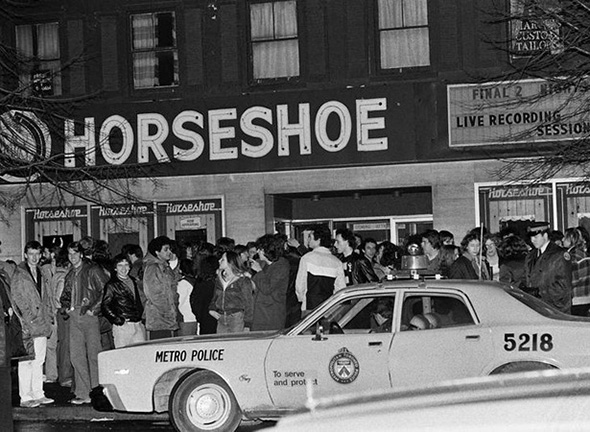
On December 1, 1978, the Garys' reign came to an end with a bang. Their final night at the club featured some of the biggest names in the Toronto punk scene, but by the end of the Viletones' raucous set the mood was starting to get rowdy. One song into headliners Teenage Head's set, Gary Topp announced that the cops were shutting down the show, and the club erupted into a riot. The infamous night was captured on film and released as The Last Pogo, and is considered one of the defining moments of that era. The Garys would go on to become major players in the local concert promoting business, but at this point Toronto wasn't quite ready for them.
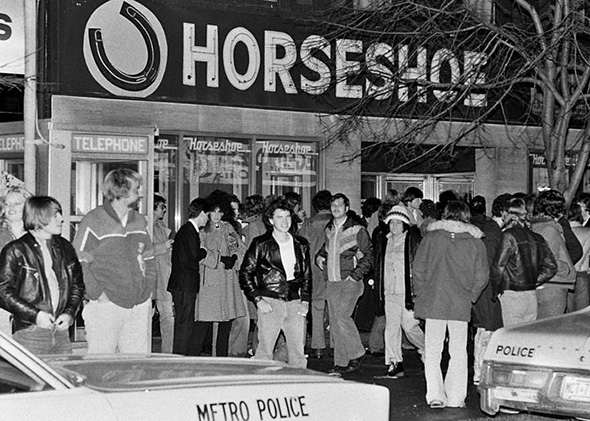
The venue struggled for several years after that notorious night. It was briefly a strip club and was also turned into a 50s themed dance club called Stagger Lee's for a period. It wasn't until 1983 that a new group of partners came in with a vision to turn the bar around and to bring the focus back to live music. Kenny Sprackman had already turned the Hotel Isabella into a new wave hotspot, and had struck up a friendship with Starr, who still owned the building. Sprackman teamed up with Michael Macrae and Richard Kruk (and according to some accounts Dan Aykroyd), and started a new era for the Horseshoe.
One of the things they brought to the table was to completely rethink how to approach booking. Instead of dealing with the musician's union, they offered bands the proceeds from the cover charge and kept the bar. This system is now fairly standard across Canada in live music bars, but at the time it was quite new, and provided opportunities for emerging acts that were willing to work hard to get a crowd out.
They also redesigned the layout, and created the separate front and back rooms we know today. But while they were making some big changes, country and roots music began to become more of the focus again, thanks to the explosion of the Queen West scene. Acts like Blue Rodeo (whose label Risque Disque was run out of the basement) and Handsome Ned were playing country with a punk-inspired attitude, which fit as well with the new wave bands as it did with the old time roots rockers.
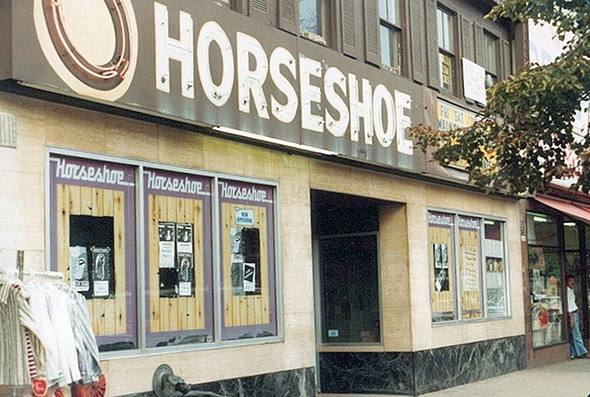
By the time the early 90s rolled around, the club was in transition again. Yvonne Matsell took over bookings, and focussed more on emerging folk rock acts like Lowest Of The Low, Rheostatics, Barenaked Ladies, and Moxy Früvous. However, the combination of the recession and the beginnings of the grunge boom hampered that approach, and by 1995 it was time for a major rethink.
Enter Jeff Cohen, who'd been building a name for himself as a booker at places like the El Mocambo and the Apocalypse club. Together with assistant Craig Laskey, they created Against The Grain promotions and brought a new energy to the club. Their combination of punk rock and alt-country fit in perfectly with the history of the venue, and CFNY personality Dave Bookman's Nu Music Nights on Tuesdays helped brand the bar as the place to go to see tomorrows stars.
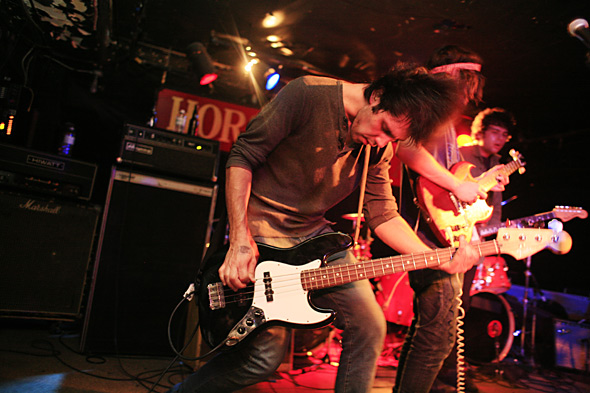
You might have stumbled upon Radiohead's Thom Yorke playing a solo set there in 1995, or maybe you remember early gigs by Arcade Fire, the Strokes, Billy Talent, the National, Death From Above, or Wilco (or maybe even Nelly Furtado). You probably didn't actually make it into the Rolling Stones' legendary 1997 "surprise" show, but you definitely heard about it, and probably know the legend of Dan Aykroyd and John Goodman doing security and working behind the bar that night.
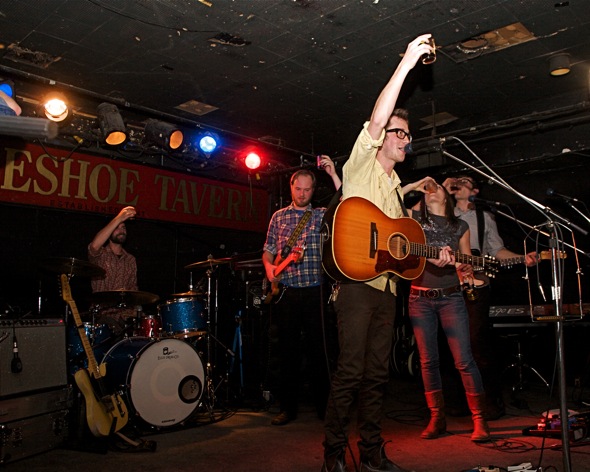
Since the 90s, the partners took over sister club Lee's Palace, ATG joined forces with promoter Amy Hersenhoren to create Collective Concerts, and ownership of the venue shifted to Jeff Cohen, Craig Laskey and Naomi Montpetit. Still, the Horseshoe feels very familiar: twangy guitars are still blaring from the stage, Teddy Fury and Bob Maynard are still behind the bars, and Tyrone is still one of the friendliest bouncers in the city.
In a city where so much history is torn down every month, it's comforting to see a living link to our cultural past continuing to thrive, and not just as a historical relic.
Please share this
Saturday, March 22, 2014
What the Sutton Place Hotel was like on opening day
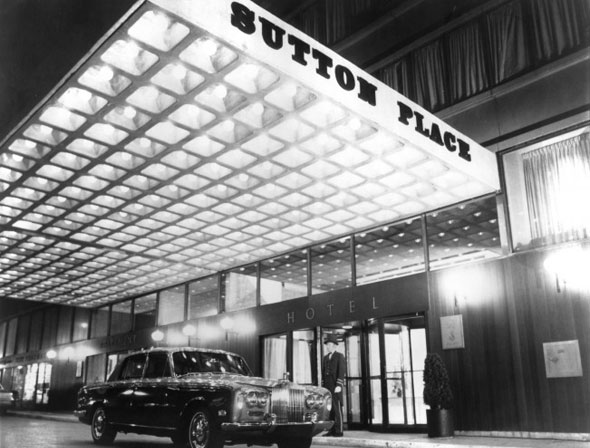
The Sutton Place Hotel, the former luxury residence at Bay and Wellesley that's currently auctioning off its TVs, couches, fireplace mantles, brass wall sconces, anything that isn't bolted down (and some stuff that is,) was, in the 1960s, undoubtedly the most prestigious place to spend the night in the city.
Liberace and Sofia Loren stayed there, and in later years so did Michael Jackson, Robin Williams, and other stars of stage and screen lured by massive suites furnished in gleaming crystal and polished Italian marble. Even the soap wrappers were custom made.
In a few years the building, once a focal point of the Toronto International Film Festival during its years in Yorkville, will be completely stripped back and reshaped into the Britt Condos.
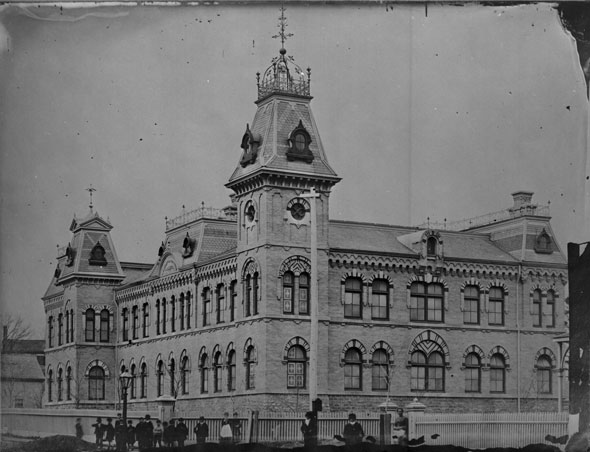
The 32-storey hotel tower was built in the mid-1960s on the site of the gorgeous and thoroughly intimidating Wellesley Public School, a gothic revival masterpiece that stood on an old creek bed. Builders had to lower the water table beneath the site by some 6 metres and install permanent pumps in the basement to keep out water prior to construction.
Thanks to a promotional supplement published in The Globe and Mail, we have detailed information about the physical structure of the building. The concrete and steel supporting structure weighed 36,000 tonnes and was 113 metres from its deepest excavation point to the top of the roof. At it's narrowest point, the building was just 20 metres wide.
The project represented a $12 million investment for its owners, who had earlier considered building apartments on the site. But the building was never about outward beauty.
When the Toronto Sutton Place Hotel opened in the summer of 1967, one in a chain named for an affluent Manhattan neighbourhood, there were 225 guest rooms and dozens more luxury apartments on the upper floors: A combination of "old-world charm and space-age elegance," the advertisers said. "The new showplace of Toronto."
"Sutton Place has Spanish bedspreads and English coach lights and two year-round swimming pools and every item in the hotel was custom ordered," the hotel boasted. "This includes 100 dozen dinner plates and 50 dozen tablecloths and 400 gold nylon shower curtains and 8,100 square yards of broadloom [carpet] and 120 escargot clamps for eating snails."
In the lobby, a 6,000 prism chandelier hung near a 23-metre historical mural that depicted the first 100 years of Canada's history. The plexiglass, gold, silver, and copper piece by Philadelphia artist Shirley Tattersfield was, for reasons that aren't entirely clear, designed to be practically indestructible. It could withstand 990 Celsius temperatures and blows from a sledgehammer, she said. "It'll last longer than anything in the hotel."
There was a pub-style lounge, a dining room, a coffee house, a banquet hall, and 650 square metres of office space that overlooked a sun patio. Up on the roof, the highest neon sign in Toronto (Sutton Place was the 4th tallest building in the city in 1967) spelled out the name of the hotel in massive 2.5 metre letters.
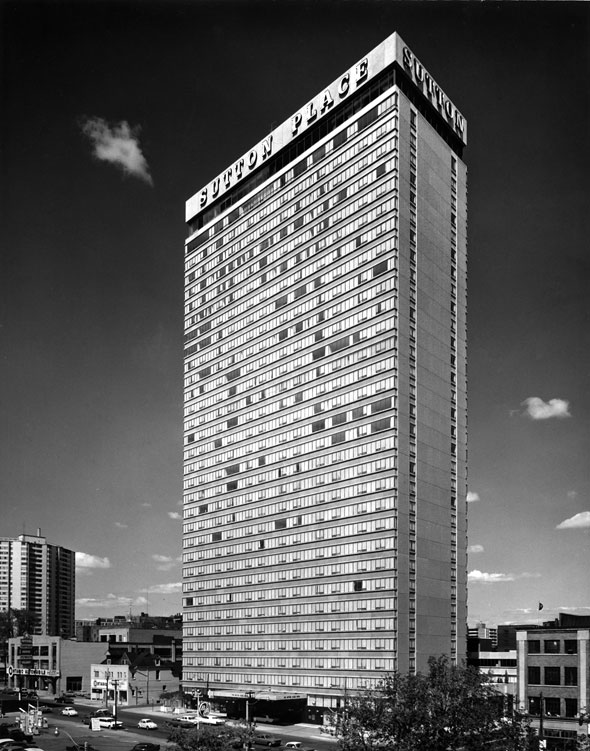
People with enough money to stay at Sutton Place were pampered by a team of impeccably uniformed staff, several of whom had European training, a fact the hotel was eager to point out. Ellen Harris, the manager of the hotel cafe, literally wrote the book on customer care - Professional Restaurant Service - and all waitresses were sent away on an intensive seven-day training course in proper serving techniques.
Continuing the tradition of importing just about every fixture, apparently just for the sake of calling it "imported," the bedrooms were decked out in a dizzying mix of materials: Mediterranean bedspreads, bamboo drapes from San Francisco, ceiling lights from Hamburg, and Swedish table lamps. "All told, more than 56 countries contributed products or materials," hotel management said.
On the ground floor, the massive stainless steel main kitchen, commanded by head chef Stanley Wieczorek, offered 1960s delights like "pheasant under glass" - pheasant breast in a rich mushroom, wine, cognac, and cream sauce shielded under a cover until it's ready to be eaten. The Sutton Place version was served with a special pheasant-shaped plush that looked a like a tea cosy.
The crowning feature of the Sutton Place tower was Stop 33, the top-floor cocktail lounge, restaurant and observation deck topped with a "midnight sky" ceiling of some 2,700 tiny individual light bulbs.
56 floor-to-ceiling windows provided panoramic views of the city at a time when there were few other tall buildings to obstruct the vista. The obsidian towers of Mies van der Rohe's TD Centre, the curving clasp of City Hall, and the Canadian Bank of Commerce building were the only obstructions to the lake.
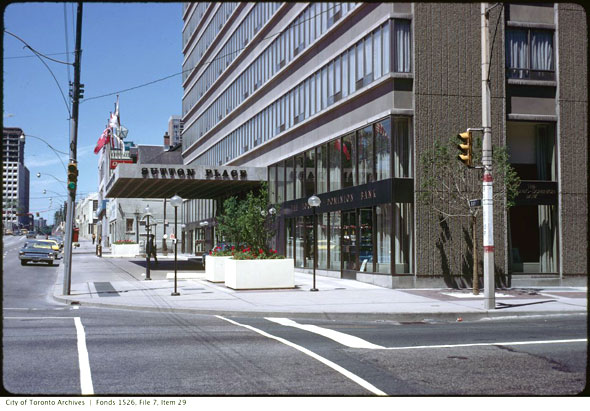
But it wasn't all monogrammed towels and room service. The opulent surroundings were rocked just three months after opening day when a bomb hidden inside the box spring bed of stock promoter Myer Rush exploded, blasting glass, bedding, and shrapnel from a sixth floor window into the street, shortly before 4 AM on Nov. 10 1967.
Rush, who was due in court the next morning to face charges in an alleged $100 million stock fraud, was critically injured: "His head, chest, and side were caved in by the force of the explosion," wrote the Toronto Star. "He was moaning 'help me, please help me,'" Fire Captain John Bird said. Paramedics thought he had a 10 per cent chance of survival.
The bomb had been hidden under the mattress in room 615 and wired to a dime-store alarm clock. Rush - who was "built like a box" and spoke as if he had "gargled with ground glass" - had probably been sleeping on top of it for close to four hours. The force of the explosion left him crumpled against the door of the room; firefighters had to break it down because the night latch was still on.
The stock promoter who had long been under police suspicion was a popular target: Earlier in the year he had been asked to select from a police line up the man who had worked him over with a baseball bat and stolen $9,000 of his money. He made his choice by punching the culprit in the face.
Amazingly, Rush survived the attempt on his life and continued his life of nefarious dealings, fleeing overseas before eventually returning to Canada in 1969 to face a 10-year jail sentence.
The Sutton Place Hotel was open for 45 years. It closed for the last time in June 2012.
Please share this
Subscribe to:
Posts (Atom)



